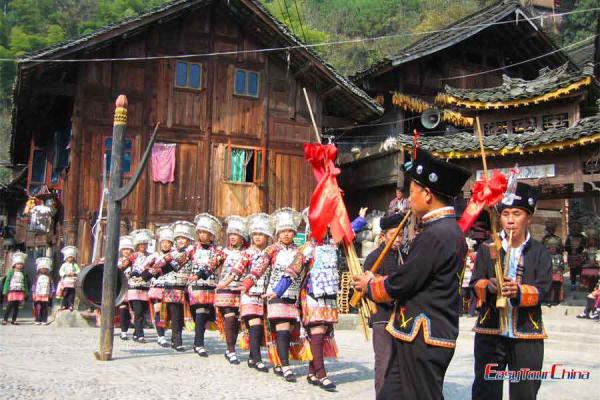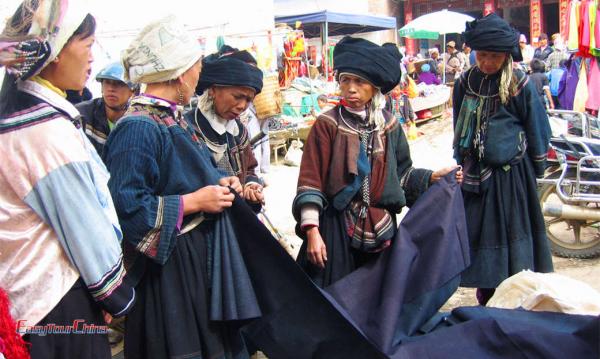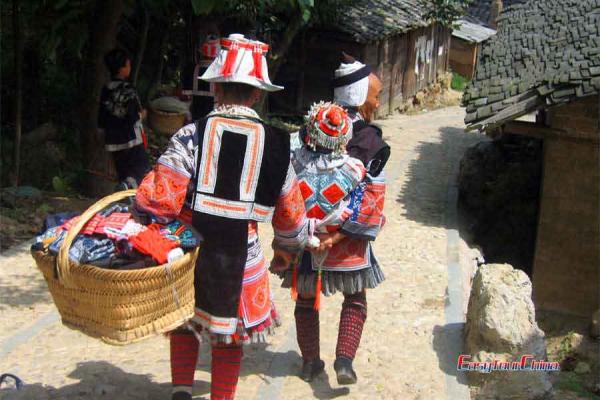Ethnic Groups in China
China is a large country noted for its dense population and vast territory. At present, there are altogether 1.4 billion people from 56 ethnic groups in China. The defining elements of an ethnic group are language, homeland, and social values. As the majority of the population is of the Han ethnic group, the other 55 ethnic groups are customarily referred to as ethnic minorities because of their relatively smaller population size compared with Han people.
Recommended China ethnic minority tours:
15-day Yunnan and Guizhou Getaway Tour
11-day Guangxi & Guizhou Mountain Tribe Adventure

Ethnic Groups in China Facts
The ethnic groups in China include: Han, Achang, Bai, Blang, Bonan, Bouyei, Dai, Daur, De'ang, Dong, Dongxiang, Dulong, Ewenki, Gaoshan, Gelo, Hani, Hezhe, Hui, Jing, Jino, Jingpo, Kazak, Kirgiz, Korean, Lahu, Li, Lisu, Lhoba, Manchu, Maonan, Miao, Moinba, Mongolian, Mulam, Naxi, Nu, Oroqen, Ozbek, Pumi, Qiang, Russian, Salar, She, Shui, Tatar, Tajik, Tibetan, Tu, Tujia, Uygur, Wa, Xibe, Yao, Yi, Yugur, Zhuang.
Various ethnic groups are widely scattered in China. In most of China's cities and county town, two or more ethnic groups live together. There are ethnic minorities living in Han nationality areas and Han people living in ethnic minority autonomous regions. This distribution pattern is formed by the interaction and flow of various ethnic groups in the long historical development process.
Ethnic Groups in China Statistics
According to the fifth national census taken in 2000, the Han people made up 91.59 percent of the country's total population, totaling 1159.4 million; and the other 55 ethnic groups, 8.41 percent, totaling 106.43 million. The Han people can be found throughout the country, though mainly on the middle and lower reaches of the Yellow River, the Yangtze River and the Pearl River valleys, and the Northeast Plain. The ethnic minorities, though fewer in number, are also scattered over a vast area, mainly distributed in the border regions from northeast China to north, northwest and southwest China.
Yunnan province has the largest ethnic composition in China, with 52 of the country's 56 ethnic groups, including 26 ethnic groups with a population of more than 5,000, and 25 ethnic minorities except the Han.
Guizhou is another province where many ethnic groups live together. There are 56 ethnic groups in guizhou, among which the Han, Miao, Buyi, Dong, Tujia, Yi, Gelao, Shui, Hui, Bai, Yao, Zhuang, She, Maonan, Manchu, Mongolian, Mulam and Qiang are the 18 main ethnic groups in Guizhou.

Ethnic Groups in China Policy
China exercises a policy of regional autonomy for various ethnic groups, allowing ethnic groups living in compact communities to establish self-government and direct their own affairs.
In May 1947, China established its first provincial-level ethnic autonomous region -- Inner Mongolia Autonomous Region -- under the leadership of the Communist Party of China.
After the founding of the People's Republic of China, the Xinjiang Uygur Autonomous Region, Guangxi Zhuang Autonomous Region, Ningxia Hui Autonomous Region and Tibet Autonomous Region were successively established. By 2017, 155 ethnic autonomous areas had been established, including five autonomous regions, 30 autonomous prefectures and 120 autonomous counties.
Of the 55 ethnic minorities in China, 44 have established ethnic autonomous areas. The number and layout of autonomous areas basically correspond to the distribution and composition of China's ethnic groups.
Ethnic Groups in China Languages and Religions
Since the founding of the People's Republic of China in 1949, the Party and the government have adhered to the policy of ethnic equality and language equality, and the use and development of spoken and written languages of ethnic minorities have received due respect and legal protection.
Among the 55 ethnic minorities, 54 have their own languages, except the Hui, who have all switched to Chinese. With the acceleration of China's modernization, some minority languages are in danger of dying out. Although China has made some achievements in the protection of minority languages, the situation of language diversity protection is still grim.
China is a country with many religions, mainly Buddhism, Taoism, Islam, Catholicism, and Protestantism. Most of the ethnic minorities in China have religious beliefs.
Among China's ethnic minorities, Tibetan, Mongolian, Tuan, Yugu, Mengba, Pumi and Naxi believe in Tibetan Buddhism (also known as Lamaism); Dai, Brown, Deang believe in Hinayana/Theravada Buddhism, ten ethnic groups including Hui, Uygur, Kazak, Dongxiang, Bao 'an, Salah, Kirgiz, Tatar, Uzbek and Tajik believe in Islam; Part of yi, Miao, Lahu, Jingpo, and Susu believe in Christianity.
Small groups of ethnic Russians and Ewenki follow orthodox Christianity. Some ethnic minorities, such as dulong, Nu, Wa, Jingpo, Gaoshan, Oroqen and Lhoba, still maintain their primitive worship of nature and various beliefs.

What are the Major Ethnic Groups in China?
According to the fifth national census in 2000, 18 ethnic minorities have a population of over one million, namely the Zhuang, Manchu, Hui, Miao, Uygur, Yi, Tujia, Mongolian, Tibetan, Bouyei, Dong, Yao, Korean, Bai, Hani, Li, Kazak and Dai.
What are the 3 Largest Ethnic Groups in China?
Han, population of 1.3 billion. Han nationality is the name of the Huaxia nationality. The appellation began in the Han Dynasty over 2000 years ago and is still used today.
Zhuang, population of 17 million, has the largest population of ethnic minorities in China, and mainly lives in Guangxi Zhuang Autonomous Region other some other areas of Southern China.
Hui, population of 1.06 million, is the most widely distributed minority in China.
The 56 Ethnic Groups in China:
| Chinese Name | English Name/Code | Pinyin | Population (by 2010) | Main Distribution Area |
|---|---|---|---|---|
| 汉 | Han/HA | hàn zú | 1.3billion | Across the country |
| 壮族 | Zhuang/ZH | Zhuàng Zú | 16,926,381x | Guangxi Zhuang Autonomous Region, Yunnan Province, Guangdong Province, Guizhou Province |
| 满族 | Man/MA | Mǎn Zú | 10,387,958x | Liaoning, Jilin, Heilongjiang, Hebei, Henan, Anhui, Jiangsu, Shanghai, Zhejiang, Guangdong, Shandong, Fujian, Hunan, Yunnan province, Beijing, Tianjin, Inner Mongolia autonomous region, Xinjiang uygur autonomous region, Shaanxi, Sichuan, Hainan, Taiwan, Hong Kong special administrative region |
| 维吾尔族 | Uyghur/UG | Wéiwúěr Zú | 10,069,346x | Xinjiang Uygur Autonomous Region, Hunan Province |
| 苗族 | Miao/MH | Miáo Zú | 9,426,007x | Guizhou, Yunnan, Hunan, Guangxi Zhuang Autonomous Region, Sichuan, Guangdong, Hubei, Hainan, Chongqing |
| 土家族 | Tujia/TJ | Tǔjiā Zú | 8,353,912x | Hunan, Hubei, Sichuan, Guizhou, Chongqing |
| 彝族 | Yi/YI | Yí Zú | 8,714,393x | Sichuan, Yunnan, Guizhou, Guangxi Zhuang Autonomous Region |
| 蒙古族 | Mongol/MG | Měnggǔ Zú | 5,981,840x | Inner Mongolia Autonomous Region, Liaoning, Jilin, Heilongjiang, Qinghai, Xinjiang Uygur Autonomous Region, Hebei province, Henan Province, Gansu Province, Yunnan Province |
| 藏族 | Tibetan/ZA | Zàng Zú | 6,282,187x | Tibet Autonomous Region, Sichuan, Qinghai, Gansu, Yunnan |
| 布依族 | Buyei/BY | Bùyī Zú | 2,870,034x | Guizhou |
| 侗族 | Dong/DO | Dòng Zú | 2,879,974x | Guizhou province, Hunan Province, Guangxi Zhuang Autonomous Region |
| 瑶族 | Yao/YA | Yáo Zú | 2,796,003x | Guangxi Zhuang Autonomous Region, Hunan, Yunnan, Guangdong, Guizhou, Sichuan |
| 朝鲜族 | Korean/CS | Cháoxiǎn Zú | 1,830,929x | Jilin province, Heilongjiang Province, Liaoning Province, Beijing, Shanghai City, Guangdong Province, Inner Mongolia Autonomous Region |
| 白族 | Bai/BA | Bái Zú | 1,933,510 | Yunnan, Guizhou |
| 哈尼族 | Hani/HN | Hāní Zú | 1,660,932x | Yunnan |
| 哈萨克族 | Kazak/KZ | Hāsàkè Zú | 1,462,588x | Xinjiang Uygur Autonomous Region, Gansu Province |
| 黎族 | Li/LI | Lí Zú | 1,463,064 | Hainan, Guangdong |
| 傣族 | Dai/DA | Dǎi Zú | 1,261,311 | Yunnan |
| 畲族 | She/SH | Shē Zú | 708,651 | Fujian, Zhejiang, Jiangxi, Guangdong, Anhui, Shanghai |
| 傈僳族 | Lisu/LS | Lìsù Zú | 702,839x | Yunnan, Sichuan |
| 仡佬族 | Gelao/GL | Gēlǎo Zú | 550,746 | Guangxi Zhuang Autonomous Region |
| 东乡族 | Dongxiang/DX | Dōngxiāng Zú | 621,500 | Gansu Province, Xinjiang Uygur Autonomous Region |
| 高山族 | Gaoshan/GS | Gāoshān Zú | 494,107 | Taiwan, Fujian |
| 拉祜族 | Lahu/LH | Lāhù Zú | 485,966 | Yunnan |
| 水族 | Sui/SU | Shuǐ Zú | 411,847 | Guizhou Province, Guangxi Zhuang Autonomous Region |
| 佤族 | Va/VA | Wǎ Zú | 429,709 | Yunnan |
| 纳西族 | Naxi/NX | Nàxī Zú | 326,295 | Yunnan, Sichuan |
| 羌族 | Qiang/QI | Qiāng Zú | 309,576 | Sichuan |
| 土族 | Tu/TU | Tǔ Zú | 289,565 | Qinghai Province, Gansu Province |
| 锡伯族 | Xibe/XB | Xíbó Zú | 190,481 | Xinjiang Uygur Autonomous Region, Liaoning Province, Jilin Province |
| 柯尔克孜族 | Kirgiz/KG | Kēěrkèzī Zú | 186,708 | Xinjiang Uygur Autonomous Region, Heilongjiang Province |
| 达斡尔族 | Daur/DU | Dáwòěr Zú | 131,992 | Guangxi Zhuang Autonomous Region |
| 景颇族 | Jingpo/JP | Jǐngpō Zú | 147,828 | Yunnan |
| 毛南族 | Maonan/MN | Màonán Zú | 101,192 | Guangxi Zhuang Autonomous Region |
| 撒拉族 | Salar/SL | Sǎlá Zú | 130,607 | Qinghai Province, Gansu Province |
| 布朗族 | Blang/BL | Bùlǎng Zú | 119,639 | Yunnan |
| 塔吉克族 | Tajik/TA | Tǎjíkè Zú | 51,069 | Xinjiang Uygur Autonomous Region |
| 阿昌族 | Achang/AC | Āchāng Zú | 39,555 | Yunnan |
| 普米族 | Pumi/PM | Pǔmǐ Zú | 42,861 | Yunnan |
| 鄂温克族 | Ewenki/EW | Èwēnkè Zú | 30,875 | Inner Mongolia Autonomous Region, Heilongjiang Province |
| 怒族 | Nu/NU | Nù Zú | 37,523 | Yunnan |
| 京族 | Gin/GI | Jīng Zú | 28,199 | Guangxi Zhuang Autonomous Region |
| 基诺族 | Jino/JN | Jīnuò Zú | 23,143 | Yunnan |
| 德昂族 | Deang/DE | Déáng Zú | 20,556 | Yunnan |
| 保安族 | Bonan/BO | Bǎoān Zú | 20,074 | Gansu Province |
| 俄罗斯族 | Russ/RS | Éluōsī Zú | 15,393x | Xinjiang Uygur Autonomous Region, Inner Mongolia Autonomous Region, Heilongjiang Province |
| 裕固族 | Yugur/YG | Yùgù Zú | 14,378 | Gansu Province |
| 乌兹别克族 | Uzbek/UZ | Wūzībiékè Zú | 10,569 | Xinjiang Uygur Autonomous Region |
| 门巴族 | Monba/MB | Ménbā Zú | 10,561 | Tibet Autonomous Region |
| 鄂伦春族 | Oroqen/OR | Èlúnchūn Zú | 8,659 | Inner Mongolia Autonomous Region, Heilongjiang Province |
| 独龙族 | Derung/DR | Dúlóng Zú | 6,930 | Yunnan |
| 塔塔尔族 | Tatar/TT | Tǎtǎěr Zú | 3,556x | Xinjiang Uygur Autonomous Region |
| 赫哲族 | Hezhen/HZ | Hèzhé Zú | 5,354 | Heilongjiang Province |
| 珞巴族 | Lhoba/LB | Luòbā Zú | 3,682x | Tibet Autonomous Region |


